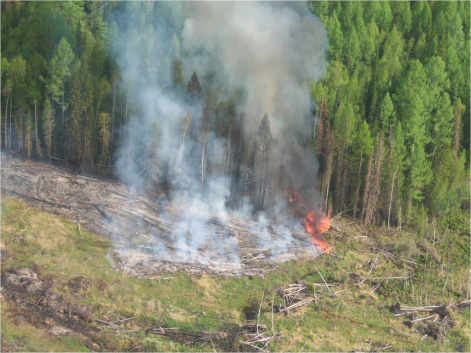Scientists revealed the relationship between the number of forest fires and human activity in Siberia
14 December 2021 г.

In Priangarye about 220 thousand hectares of forest are annually burned down, and 31 thousand hectares are cut down. Just in the last 20 years, fires and logging have affected slightly more than 4.1 million hectares (38% of the region area) and 0.6 million hectares (6% of the area), respectively. Over the past six years, according to researchers, the logging area in the region has significantly increased. At the same time, there is a tendency for both fellings and fires to spread to the northern, previously undisturbed areas of the Lower Angara region. Scientists believe that this is due to the depletion of forest resources in the southern regions subjected to anthropogenic impact for a long time.
An international team of researchers from Russia, Canada and the United States, including scientists from the Federal Research Center KSC SB RAS, analyzed the distribution of fires and logging in the Angara region over the past two decades and traced the relationship between the location of fires, logging, settlements and roads. The analysis showed that almost half of the fires occurred at a distance of two kilometers or smaller from anthropogenic objects.
To test whether the fires were caused by human activity, scientists analyzed the distance between fires and various man-made objects, in particular, deforested areas, roads and settlements. Researchers traced the dates and locations of the fires using satellite data.
The analysis revealed the exponential relationship between the number of fires and their distance from settlements and roads. Almost 75% of the burned-out areas are located in the 20 km zone around the roads. At the same time, in highly populated areas with a well-developed road network, slightly more than half of the fires occur at a distance of no more than 5 kilometers from the roads while in regions with low population and poorly developed road network, only one fifth of the fires occur within these boundaries. The number of forest fires increases when approaching anthropogenic objects, while the average area of fires decreases.
“Boreal forests play an important role in climate regulation. Assessment of the current state of boreal forests is essential for the development of strategies for sustainable forest management and conservation of primary forests. An increasing number of Siberian forests, for example in the Angara region, are facing extreme load represented by growing fires and logging. We found an increase in the frequency of fires near anthropogenic objects. Half of all the fires detected in the region occurred at a distance of no more than two kilometers from the clear-cut areas; more than 60% of fires are found to be in the four-kilometer zone around the clearings. This suggests that most fires in the region are caused by human activities,” said Elena Kukavskaya, Candidate of Biological Sciences? Senior researcher at the V.N. Sukachev Institute of Forest SB RAS.
According to experts, in the cut-down areas, due to a greater amount of direct sunlight, the forest floor dries out earlier and, therefore, an increase in fire hazard compared to undisturbed forests, and an increase in the stocks of felling residues in clearings result in the development of high-intensity fires. The presence of roads and nearby settlements also increases the risk of fires.
“Man is not the only source of fire in the forest. A significant number of fires are associated with thunderstorms. Anthropogenic activity both increases the likelihood of a fire and contributes to its extinguishing. For example, roads not only increase the risk of human-caused fires, but they also prevent the spread of fire and facilitate the delivery of extinguishing equipment. Settlements contribute to faster fire detection. The study also show that anthropogenic fires tend to be smaller in size than remote natural fires.” explained the scientist.
The influence of man on the forests of the Angara region due to logging and fires has been increasing in recent decades. In this regard, scientists are talking about the need to complete and strictly observe environmental regulations, as well as to develop an appropriate policy for forest conservation and sustainable forest management in Siberia.
The study was supported by a grant from the Russian Foundation for Basic Research and Government of Krasnoyarsk (project №20-44-242004).
Share:
